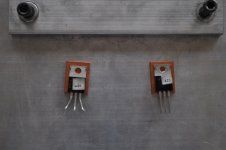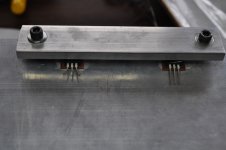I see the Fairchild 19N and 12P parts are much cheaper a 1/3 of the price of the IRFP parts.
As I have not bought yet.....what should I buy? Why did you use the Fairchild parts 6L6?
Normally the Fairchild parts are the more expensive choice...
Anyway, I used them because Buzzforb had them tightly matched and available.
You don't really want to use the TO-220 parts, they are too small.
TO-247 or TO-3P are the bigger packages.
TO-247 or TO-3P are the bigger packages.
You don't really want to use the TO-220 parts, they are too small.
TO-247 or TO-3P are the bigger packages.
What is the impact of being too small? They cannot dissipate as much heat?
In the F4, the MOSFETs only dissipate about 10 watts each, which should not be a problem with their smaller footprint. If you need to dissipate 30 watts each, you can attach TO-220 MOSFETs to copper heat spreaders using thermal epoxy and clamp them to the heatsink like shown below. In the left image, the TO-220 FETs had not yet been glued to the copper. In the right image, the FETs are secured to the heatsink using an aluminum bar and misc&grease insulation.What is the impact of being too small? They cannot dissipate as much heat?
Attachments
From the data sheets:
FQA12P20 has 150 W; FQP12P20 has 120 W dissipation.
FQA19N20 HAS 190 W; FQP19N20 HAS 140 W dissipation
With F4, 6 devices per channel @ (120 watt & 140) = 720 & 840 watt max total dissipation using TO-220. Seems like you would be OK.
Have I got this right? The Fairchild FQP are readily available from Mouser (last I checked) - easier to get. FQA are discontinued. Otherwise, it would not matter to me.
FQA12P20 has 150 W; FQP12P20 has 120 W dissipation.
FQA19N20 HAS 190 W; FQP19N20 HAS 140 W dissipation
With F4, 6 devices per channel @ (120 watt & 140) = 720 & 840 watt max total dissipation using TO-220. Seems like you would be OK.
Have I got this right? The Fairchild FQP are readily available from Mouser (last I checked) - easier to get. FQA are discontinued. Otherwise, it would not matter to me.
They will work fine. I would not push them as hard as their bigger brethren. In an F4, I don't see it being an issue.
Teabag made his F5T PCBs to accommodate TO220s. They would be OK there and F5 as well it seems.
I want to see your heatsink and power supply for 800 watts dissipation. I do not think Papa really intended to scale the F4 that far, although it might be done. If you want that power level you should consider increasing the number of MOSFETs.
From the data sheets:
FQA12P20 has 150 W; FQP12P20 has 120 W dissipation.
FQA19N20 HAS 190 W; FQP19N20 HAS 140 W dissipation
With F4, 6 devices per channel @ (120 watt & 140) = 720 & 840 watt max total dissipation using TO-220. Seems like you would be OK.
Have I got this right? The Fairchild FQP are readily available from Mouser (last I checked) - easier to get. FQA are discontinued. Otherwise, it would not matter to me.
My point is the smaller packages can dissipate a lot more power than will be required in an F4. It is not that I am trying to run them at maximum capacity.
If using the BA-3 front-end with a crippled F4, there is one more capacitor in the chain than is necessary. In the BA-3 there is the output capacitor C3. In the crippled F4 there are C1 and C2. Is there any agreement about which one to eliminate? The most obvious choices are:
- Eliminate the BA-3 output capacitor C3 directly connecting to the node between C1 and C2 in the F4.
- Eliminate F4 capacitor C2 as is done in the BA-2 output stage.
Eliminate the F4 cap C2, to try to make it look as much like a complimentary Burning Amp as possible.
However, both approaches are easy to do, I suggest trying both to see if one sounds subjectively better than the other.
However, both approaches are easy to do, I suggest trying both to see if one sounds subjectively better than the other.
Any benefit using toshiba 2sk1530/2SJ201 outputs, will 2nd order harmonic character changes the sound for better or worse?
Does this nice sounding amp deserve better parts or not applicable in this case?
Does this nice sounding amp deserve better parts or not applicable in this case?
feel free to try
THD spectra will be slightly diff. , but question is will you hear it and then what you're going to like more
THD spectra will be slightly diff. , but question is will you hear it and then what you're going to like more
Any benefit using toshiba 2sk1530/2SJ201 outputs, will 2nd order harmonic character changes the sound for better or worse?
Does this nice sounding amp deserve better parts or not applicable in this case?
I believe in the F4 the use of those sought after Toshibas will be a waste as you probably wont be able hear it's sonic fingerprint, not as when used in the F5 or F5T.
hi all
if I run 1 pair of the fqa parts per side (like the m2) can I just remove the unused mosfets and their .47/100r resistors without any other circuit changes
what power into 8 ohm can I expect after doing this ? same as m2
I will be running it of the ba3 frontend
Sheafer
if I run 1 pair of the fqa parts per side (like the m2) can I just remove the unused mosfets and their .47/100r resistors without any other circuit changes
what power into 8 ohm can I expect after doing this ? same as m2
I will be running it of the ba3 frontend
Sheafer
Any benefit using toshiba 2sk1530/2SJ201 outputs, will 2nd order harmonic character changes the sound for better or worse?
Does this nice sounding amp deserve better parts or not applicable in this case?
I believe in the F4 the use of those sought after Toshibas will be a waste as you probably wont be able hear it's sonic fingerprint, not as when used in the F5 or F5T.
The Toshiba's are a closer complementary match. This should allow for lower distortion.
The Toshiba's are a lower Vgs in comparison to the Fairchild or IRF parts allowing the Rs to be about half the .47 ohms, maybe .22 ohms, creating a lower output impedance and better drive for low impedance loads.
- Home
- Amplifiers
- Pass Labs
- F4 power amplifier


